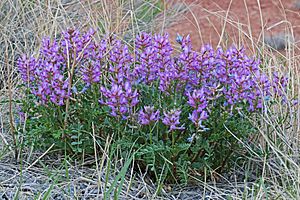Astragalus preussii facts for kids
Quick facts for kids Astragalus preussii |
|
|---|---|
 |
|
| Scientific classification |
Preuss' milkvetch (Astragalus preussii) is a special plant found in the southwestern United States. It grows in places like the Colorado Plateau and Canyonlands. This plant is part of the legume family, just like peas and beans. It can be an annual plant, meaning it lives for one year, or a perennial plant, meaning it lives for many years.
Contents
What Does Preuss' Milkvetch Look Like?
How It Grows
Preuss' milkvetch can grow to be about 4 to 15 inches (10 to 38 cm) tall. It stands upright and grows from a strong, woody base. This plant can live for just one year or come back year after year.
Leaves and Stems
Its leaves are quite interesting! They are called compound pinnate leaves, which means they have many smaller leaflets arranged along a central stem. Each leaf can be from 1.5 to 15 inches (4 to 38 cm) long. On each leaf, you'll find 7 to 25 small, oval-shaped leaflets, each about 0.75 inches (1.9 cm) long.
Flowers and Fruits
This plant shows off its beautiful flowers from March to June. Each flower stalk can have anywhere from 3 to 22 flowers. Each flower has a small, green, cup-like structure called a calyx with five lobes. Inside this calyx are the petals, which can be white, pink, or purple. These petals form a tube shape and are about 0.75 inches (1.9 cm) long.
After the flowers bloom, they turn into seed pods. These pods are about 0.75 inches (1.9 cm) long and are shaped like an oval. When they dry, they become papery or leathery. Some pods are smooth, while others are covered with soft hairs.
Where Does Preuss' Milkvetch Live?
Preuss' milkvetch is quite picky about where it grows! It can only be found in soils that contain a special element called Selenium. This makes its habitat very specific, usually in certain areas of the southwestern United States.
Who Was Charles Preuss?
This interesting plant is named after a person named Charles Preuss. He was a German-American cartographer, which means he was a mapmaker. He explored parts of the American West in the 1840s. Scientists often name new plants or animals after the people who discovered them or helped study them.

